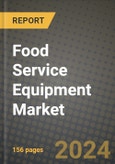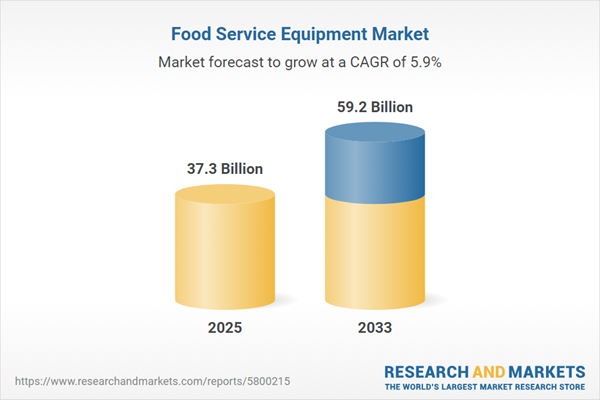Food Service Equipment Market Overview
- The Food Service Equipment Market is witnessing significant growth, driven by the expanding food and beverage industry, rising consumer demand for dining-out experiences, and the increasing adoption of energy-efficient kitchen solutions. Food service equipment includes a broad range of products such as cooking appliances, refrigeration units, dishwashing equipment, and food preparation tools, catering to commercial kitchens, restaurants, hotels, and institutional food services. The growing influence of quick-service restaurants (QSRs), cloud kitchens, and food delivery services is fueling demand for innovative and high-performance equipment that ensures speed, efficiency, and food safety. Technological advancements, including smart cooking equipment with IoT-enabled monitoring, are transforming kitchen operations by enhancing automation and reducing operational costs. Additionally, sustainability is becoming a key focus, with manufacturers introducing energy-efficient appliances to comply with stringent environmental regulations and reduce carbon footprints. As food service businesses prioritize cost-effectiveness and operational efficiency, investments in durable, multi-functional, and automated food service equipment continue to surge, shaping the competitive landscape of the market.
- In 2024, the Food Service Equipment Market has experienced strong momentum due to evolving consumer dining preferences, increasing investments in restaurant infrastructure, and advancements in commercial kitchen technology. The demand for energy-efficient and space-saving appliances has surged as food service operators seek solutions to optimize kitchen workflows and minimize utility costs. The rapid proliferation of ghost kitchens and virtual restaurants has driven the adoption of compact, high-capacity cooking and food preparation equipment tailored for delivery-based food businesses. Additionally, the integration of automation and AI-driven systems has gained traction, with robotic chefs and automated order-processing solutions improving service speed and consistency. Food safety regulations have further intensified, prompting food service establishments to invest in advanced refrigeration and sanitization systems to ensure compliance. Meanwhile, economic uncertainties and fluctuating raw material prices have posed challenges for equipment manufacturers, leading to strategic collaborations, cost optimization initiatives, and localized supply chain adjustments.
- Looking ahead to 2025 and beyond, the Food Service Equipment Market is set for continued innovation and expansion, with smart technology, sustainability, and automation taking center stage. Manufacturers will increasingly focus on AI-powered kitchen solutions that enhance efficiency, track inventory, and optimize energy consumption. The rise of self-service kiosks, automated beverage dispensers, and robotic cooking stations will redefine food service operations, catering to evolving consumer expectations for convenience and personalization. Sustainability-driven regulations will accelerate the shift toward eco-friendly materials and energy-efficient appliances, compelling industry players to introduce new product lines that meet stringent environmental standards. The Asia-Pacific region is expected to emerge as a high-growth market, fueled by rapid urbanization, increasing disposable incomes, and the expansion of international and local food chains. Additionally, the growing popularity of plant-based and alternative protein menus will create demand for specialized food processing and preparation equipment. As competition intensifies, innovation in connectivity, automation, and modular kitchen design will drive differentiation and market leadership in the food service equipment sector.
Key Insights: Food Service Equipment Market
- Rise of Smart Kitchen Equipment: The adoption of AI-powered and IoT-enabled food service equipment is enhancing automation, real-time monitoring, and predictive maintenance, improving overall kitchen efficiency.
- Growth of Ghost Kitchens: The increasing popularity of delivery-only food businesses is driving demand for compact, high-performance cooking appliances that maximize space efficiency and speed up meal preparation.
- Sustainable and Energy-Efficient Equipment: Rising environmental concerns are prompting manufacturers to develop energy-efficient appliances that reduce water and power consumption while maintaining performance.
- Advanced Food Safety Technologies: Innovations in temperature-controlled storage, UV sanitation, and contactless handling systems are ensuring food safety and hygiene in commercial kitchens.
- Expansion of Modular Kitchen Solutions: Restaurants and food chains are increasingly adopting modular and flexible kitchen equipment that allows for easy customization and adaptation to changing business needs.
- Rising Demand for Quick-Service Restaurants: The expansion of QSRs and fast-casual dining establishments is fueling demand for high-speed, efficient food service equipment.
- Technological Advancements in Kitchen Automation: Increasing investment in smart kitchen appliances, robotic cooking stations, and automated beverage dispensers is driving market growth.
- Stringent Food Safety Regulations: Growing concerns over foodborne illnesses and contamination risks are prompting businesses to invest in advanced sanitization and temperature control equipment.
- Expansion of the Hospitality Sector: Growth in hotels, catering services, and institutional food facilities is boosting demand for high-quality, durable, and multifunctional kitchen equipment.
- High Initial Investment Costs: The adoption of advanced and energy-efficient food service equipment requires significant capital expenditure, posing a challenge for small and medium-sized food businesses with limited budgets.
Food Service Equipment Market Segmentation
By Equipment:
- Food Preparation Equipment
- Drink Preparation Equipment
- Heating And Holding Equipment
- Cooking Equipment
- Refrigerators And Chillers
- Baking Equipment
- Merchandisers
- Ware Washing Equipment
- Other F&B Service Equipment
By Distribution Channel:
- Online
- Offline
By End-User:
- Full Service Restaurant
- Quick Service Restaurant
- Institutional
- Other End-Users
By Geography:
- North America (USA, Canada, Mexico)
- Europe (Germany, UK, France, Spain, Italy, Rest of Europe)
- Asia-Pacific (China, India, Japan, Australia, Vietnam, Rest of APAC)
- The Middle East and Africa (Middle East, Africa)
- South and Central America (Brazil, Argentina, Rest of SCA)
Food Service Equipment Market Size Data, Trends, Growth Opportunities, and Restraining Factors:
- This comprehensive Food Service Equipment market report delivers updated market size estimates from 2024 to 2034, offering in-depth analysis of the latest Food Service Equipment market trends, short-term and long-term growth drivers, competitive landscape, and new business opportunities. The report presents growth forecasts across key Food Service Equipment types, applications, and major segments, alongside detailed insights into the current Food Service Equipment market scenario to support companies in formulating effective market strategies.
- The Food Service Equipment market outlook thoroughly examines the impact of ongoing supply chain disruptions and geopolitical issues worldwide. Factors such as trade tariffs, regulatory restrictions, production losses, and the emergence of alternatives or substitutes are carefully considered in the Food Service Equipment market size projections. Additionally, the analysis highlights the effects of inflation and correlates past economic downturns with current Food Service Equipment market trends, providing actionable intelligence for stakeholders to navigate the evolving Food Service Equipment business environment with precision.
Food Service Equipment Market Competition, Intelligence, Key Players, and Winning Strategies to 2034:
- The 2025 Food Service Equipment Market Research Report identifies winning strategies for companies to register increased sales and improve market share.
- Opinions from senior executives from leading companies in the Food Service Equipment market are imbibed thoroughly and the Food Service Equipment industry expert predictions on the economic downturn, technological advancements in the Food Service Equipment market, and customized strategies specific to a product and geography are mentioned.
- The Food Service Equipment market report is a source of comprehensive data and analysis of the industry, helping businesses to make informed decisions and stay ahead of the competition. The Food Service Equipment market study assists investors in analyzing On Food Service Equipment business prospects by region, key countries, and top companies' information to channel their investments.
- The report provides insights into consumer behavior and preferences, including their buying patterns, brand loyalty, and factors influencing their purchasing decisions. It also includes an analysis of the regulatory environment and its impact on the Food Service Equipment industry. Shifting consumer demand despite declining GDP and burgeoning interest rates to control surging inflation is well detailed.
What's Included in the Report?
- Global Food Service Equipment market size and growth projections, 2024-2034
- North America Food Service Equipment market size and growth forecasts, 2024-2034 (United States, Canada, Mexico)
- Europe market size and growth forecasts, 2024-2034 (Germany, France, United Kingdom, Italy, Spain)
- Asia-Pacific Food Service Equipment market size and growth forecasts, 2024-2034 (China, India, Japan, South Korea, Australia)
- Middle East Africa Food Service Equipment market size and growth estimate, 2024-2034 (Middle East, Africa)
- South and Central America Food Service Equipment market size and growth outlook, 2024-2034 (Brazil, Argentina, Chile)
- Food Service Equipment market size, share and CAGR of key products, applications, and other verticals, 2024-2034
- Short- and long-term Food Service Equipment market trends, drivers, challenges, and opportunities
- Food Service Equipment market insights, Porter’s Five Forces analysis
- Profiles of 5 leading companies in the industry - overview, key strategies, financials, product portfolio and SWOT analysis
- Latest market news and developments
Key Questions Answered in This Report:
- What is the current Food Service Equipment market size at global, regional, and country levels?
- What is the market penetration of different types, Applications, processes/technologies, and distribution/sales channels of the Food Service Equipment market?
- What will be the impact of economic slowdown/recission on Food Service Equipment demand/sales?
- How has the global Food Service Equipment market evolved in past years and what will be the future trajectory?
- What is the impact of growing inflation, Russia-Ukraine war on the Food Service Equipment market forecast?
- What are the Supply chain challenges for Food Service Equipment?
- What are the potential regional Food Service Equipment markets to invest in?
- What is the product evolution and high-performing products to focus in the Food Service Equipment market?
- What are the key driving factors and opportunities in the industry?
- Who are the key players in Food Service Equipment market and what is the degree of competition/Food Service Equipment market share?
- What is the market structure /Food Service Equipment Market competitive Intelligence?
Available Customizations:
The standard syndicate report is designed to serve the common interests of Food Service Equipment Market players across the value chain, and include selective data and analysis from entire research findings as per the scope and price of the publication.However, to precisely match the specific research requirements of individual clients, several customization options are offered to include the data and analysis of interest in the final deliverable.
Some of the customization requests are as mentioned below:
- Segmentation of choice - Clients can seek customization to modify/add a market division for types/applications/end-uses/processes of their choice.
- Food Service Equipment Pricing and Margins Across the Supply Chain, Food Service Equipment Price Analysis / International Trade Data / Import-Export Analysis.
- Supply Chain Analysis, Supply-Demand Gap Analysis, PESTLE Analysis, Macro-Economic Analysis, and other Food Service Equipment market analytics.
- Processing and manufacturing requirements, Patent Analysis, Technology Trends, and Product Innovations.
- Further, the client can seek customization to break down geographies as per their requirements for specific countries/country groups such as South East Asia, Central Asia, Emerging and Developing Asia, Western Europe, Eastern Europe, Benelux, Emerging and Developing Europe, Nordic countries, North Africa, Sub-Saharan Africa, Caribbean, The Middle East and North Africa (MENA), Gulf Cooperation Council (GCC) or any other.
- Capital Requirements, Income Projections, Profit Forecasts, and other parameters to prepare a detailed project report to present to Banks/Investment Agencies.
Additional support:
- All the data presented in tables and charts of the report is provided in a separate Excel document
- Print authentication allowed on purchase of online versions
- 10% free customization to include any specific data/analysis to match the requirement
- 7 days of analyst support
This product will be delivered within 1-3 business days.
Table of Contents
Companies Mentioned
- Electrolux
- Libbey Inc
- Tupperware Brands Corporation
- Duke Manufacturing Co Inc
- Cambro Manufacturing Company, Inc
- Hoshizaki Electric Co, Ltd
- Dover Corporation
- Rational AG
- Manitowoc Foodservice Inc
- Middleby Corporation
- Ali Group
- Coreco
- Liebherr
- Infrico
- Bizerba
- Micro Matic
- Hobart Corporation
Table Information
| Report Attribute | Details |
|---|---|
| No. of Pages | 150 |
| Published | August 2025 |
| Forecast Period | 2025 - 2033 |
| Estimated Market Value ( USD | $ 37.3 Billion |
| Forecasted Market Value ( USD | $ 59.2 Billion |
| Compound Annual Growth Rate | 5.9% |
| Regions Covered | Global |
| No. of Companies Mentioned | 17 |









